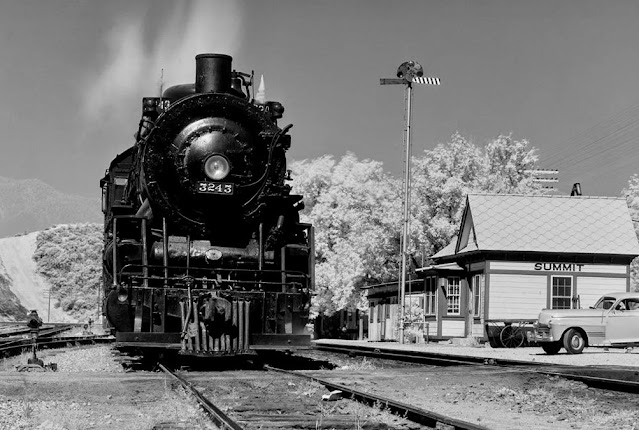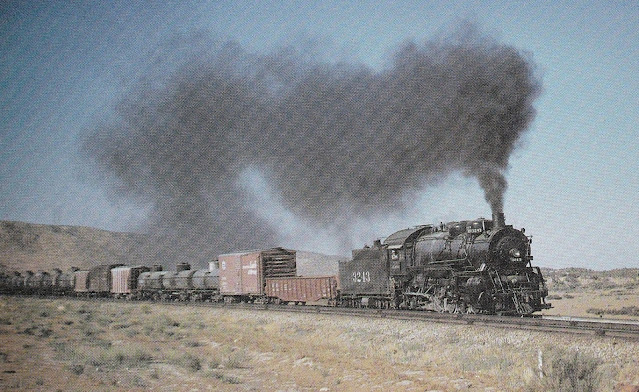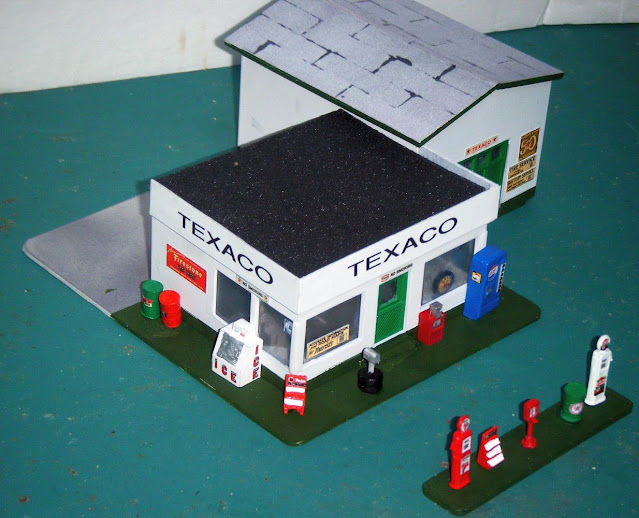I had hoped to write this blog entry two weeks after my previous one, but I was so busy downloading, labeling, and emailing photos from my Europe trip that I had no free time. That temporary hobby finally ended this week, so I can now write another blog entry, three weeks after my last one.
The locomotive topic this time will be Santa Fe's 3160-class 2-8-2s, which were very similar to the later 4000-class that we covered here previously (Dec. 12, 2021). And my layout topic this time will be mostly about the friends who are helping to build structures for my layout.
During 1917-1920 the Santa Fe acquired 128 heavy 2-8-2 steam locos from Baldwin in the 3160 class (#3160-3287). These arrived in batches with minor differences, and all were upgraded over time.
They were scrapped during 1950-1956, but the last published photos I've seen on Cajon Pass were in 1952, when just one of them (#3243) was used during the June Spud Rush, when many diesels were sent to the Valley Division to help there.
Let's begin with a color shot of #3236 with a passenger special at Redondo in 1950:
Here we see 2-8-2 #3221 helping 4-8-4 #2924 with a westbound Shriner Special near Frost (just after leaving Victorville) in June, 1950, thanks to Frank Peterson:
G.M. Best shot this classic photo of #3236 in San Bernardino in Dec. 1948:
Here is #3243 by the San Bernardino sand tower in an undated photo:
Jack Whitmeyer photographed #3243 helping 2-10-2 #3889 with an eastbound freight at Ono in June, 1952 (the Spud Rush again):
Here we see #3243 with a westbound local freight approaching Summit in June, 1952, thanks to Robert Hale:
Here is the face of #3243 by the Summit depot, probably in June, 1952:
Finally, here's a color shot of #3243 again, approaching Summit with a westbound local freight in June, 1952, thanks to Jack Whitmeyer, who was in the same photo line as Robert Hale (two photos back):
There have been quite a few HO scale brass models of various versions of these locos (along with the similar 4000 class) over the decades, such as by PFM in 1962-63, Sunset in 1977, Key in 1988, and Sunset again in 1992, and I have a few of them.
Here is the early PFM brass model of an as-built 3160-class loco (with a coal tender):
Here's a 1978 Sunset brass model with the rare "trident-shaped" feedwater heater:
Here's a later (1992) Sunset model of the 3160 class:
Finally, Key made three versions of the 3160 class in 1988, including this example:
Now let's turn to my very slow layout progress (due to my temporary hobby of sending out Europe trip photos instead). But there was good progress by my friends on building structures for the layout.
My newest helper, Craig Wisch in Victorville, who had completed a nice HO cardstock model of the old jail in Victorville, and who had suddenly disappeared from our frequent email discussions as of May 25, was later found. It turns out that he had accidentally blocked all emails from me. Jim Coady, who writes to both of us, got us back in touch after about two weeks.
Craig has made visits to the Victorville Switching Station in the Lower Narrows to get photos and dimensions of all the sides. Here's a photo of the prototype -- the building is called the Control House:Craig initially began work on an S-scale cardstock model, as he usually does, but then he set it aside and is now working on an HO-scale model. Here's an early view of the front side of his model, with the door and windows inset by 12":
Also, my local friend Don Hubbard has been adding more details to his beautiful model of the Texaco gas station that was beside Route 66 in the Lower Narrows. Here are some recent views of his model -- first, the right side, with the delicate phone booth kit he built:
And the left side, with many detail parts added:
My local friend Bill Messecar has also been busy making pencil drawings of the two section houses and a shed that stood near the water tanks, as seen in this cropped view of a Jack Whitmeyer photo:
We only have partial views of these buildings, plus footprint drawings and dimensions from the Water Service Records, but the key ingredient will be the board-and-batten siding on the buildings.
Bill is also interested in building the two steel water tanks to complete the scene, so I located my two old BH-Models kits for the 60' tall Santa Fe tanks (later Rix made a lot of the same kits).
As I said, my layout progress has been very slow. But a couple of weeks ago my local friend George Chambers came over one morning to get me going again.
We decided to fill in all the gaps between the cork sheets that will support the staging yards. I inserted latex caulk into the gaps, and he came long behind me to smooth them out. George posed for a photo when we were done with the job:
Later I sanded the dried patches and then painted over them with gray paint.
A big job ahead of me is to build and wire the four mainline control panels that Don Borden drew in CAD for me, based on all the advice from my electrical expert, Tim Fisher. Here's a recent photo I shot off all four panel drawings arranged on the floor:
I sent the drawings to Kevin Hunter at his Berrett Hill company, and he sent me back a total purchase list of Touch Toggles and related parts needed for all four panels. I had sticker shock, so the new plan is to order just the parts for the simplest panel (C Tower) to spread out the costs and the work. Better to practice on just one panel!
I hope to get back to my previous schedule of a blog entry every two weeks now.



















No comments:
Post a Comment